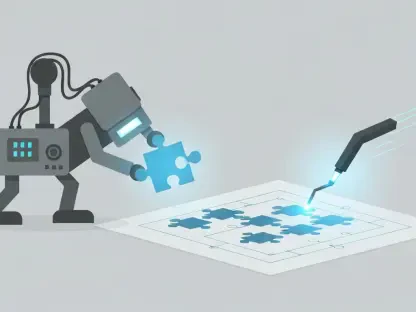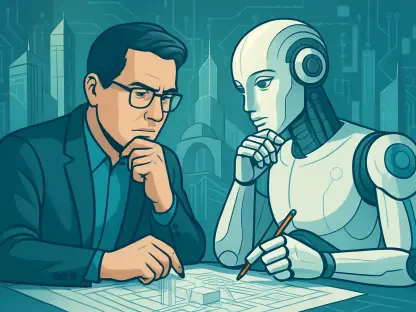The realm of software development is undergoing a significant transformation, driven by the rapid advancements in artificial intelligence (AI). As AI tools and technologies become increasingly sophisticated, they offer unprecedented benefits to collaborative software development teams. This article explores how AI is reshaping team dynamics, enhancing productivity, and facilitating better communication.
The Shift to AI-Augmented Development
Automating Routine Tasks and Improving Efficiency
AI-augmented development has revolutionized how software teams handle repetitive tasks such as bug detection, code reviews, and version control. Automated systems like GitHub Copilot and DeepCode are leading this transformation by offering real-time suggestions that make code cleaner and development faster. By taking over these routine tasks, AI allows developers to concentrate on solving complex problems, which significantly boosts productivity and efficiency. Moreover, the reduction in manual intervention in these processes facilitates smoother collaboration among team members.
This level of automation also extends to debugging processes where AI can identify and even fix common bugs without human intervention. As AI handles the mundane aspects of coding, developers have more time to innovate and focus on higher-order challenges. Furthermore, the consistency that AI-driven tools bring to the development process is invaluable. By ensuring that coding standards are uniformly applied, these tools help in maintaining the quality and reliability of the software. This uniformity benefits not only individual projects but also contributes to the overall efficiency and effectiveness of entire development teams.
Enhancing Code Quality and Consistency
The introduction of AI has led to a marked improvement in code quality and consistency, an aspect that is often challenging to maintain in large, diverse teams. AI tools not only assist in writing better code but also help enforce coding standards across the team, which is particularly beneficial for junior developers who can work more independently while adhering to best practices set by more experienced colleagues. This approach minimizes team friction and ensures project timelines are met more reliably, elevating the overall performance of the development team.
AI algorithms can sift through numerous lines of code to identify potential issues, structural flaws, or deviations from the standard coding practices. In doing so, they act as virtual mentors, guiding less experienced developers toward writing code that meets the quality benchmarks set by the team. Moreover, AI can adapt its feedback based on the coding style and requirements unique to each project, making it a versatile tool for maintaining code quality. By incorporating AI-driven reviews into the workflow, teams can achieve higher consistency and reliability in their software products.
Enhancing Cross-Functional Collaboration
Bridging Communication Gaps in Agile Environments
In agile development settings, constant interaction between developers, testers, product managers, and business users is crucial. Effective communication and seamless coordination ensure that the team’s collective efforts culminate in successful project outcomes. AI-driven project management platforms like Asana and Jira play a pivotal role in bridging communication gaps and optimizing task allocation. These tools analyze team performance and pinpoint skill gaps, ensuring tasks are assigned efficiently. By predicting potential roadblocks and suggesting improved workflows, these platforms contribute to better project outcomes and a smoother collaborative process.
AI’s capabilities extend to monitoring project timelines, resource utilization, and workload distribution. By offering data-driven insights, these tools help project managers make informed decisions that bolster team performance. The ability to predict bottlenecks and adjust resources in real-time ensures that tasks are completed on schedule, reducing delays and promoting a more agile and responsive development environment. Furthermore, AI-powered analytics can identify areas for skill development within the team, fostering continuous improvement and upskilling initiatives that benefit both the team and the organization.
Translating Technical Jargon for Inclusivity
AI’s natural language processing (NLP) capabilities are revolutionary for cross-functional collaboration. AI-powered chatbots and virtual assistants interpret complicated technical jargon and translate it into layman’s terms, making it comprehensible for non-technical stakeholders like product managers and clients. This inclusivity ensures that every team member, regardless of their technical background, is on the same page, facilitating more effective collaboration and decision-making. By acting as linguistic bridges, these AI tools help to break down barriers that traditionally hinder seamless communication.
This interpretative ability fosters a more inclusive environment where input from all stakeholders is not only welcomed but also better understood. When everyone speaks the same language, metaphorically speaking, it reduces misunderstandings and aligns the team towards common objectives. AI’s ability to translate complex concepts into simple, understandable terms is particularly valuable during project planning and review meetings, where diverse inputs are crucial. By ensuring that all voices are heard and understood, AI-powered communication tools enable more inclusive and democratic decision-making processes.
Boosting Remote and Distributed Teams
Overcoming Remote Work Challenges
The rise of remote work has introduced challenges related to communication, coordination, and maintaining productivity across different time zones. Traditional methods of team management and communication often fall short in remote settings, but AI-powered collaboration tools like Slack and Microsoft Teams help bridge these gaps. By analyzing communication patterns, these tools can flag potential miscommunications and suggest optimal meeting times based on team members’ availability. This ensures that remote teams operate as smoothly as co-located ones, maintaining efficiency and cohesion.
AI also supports remote teams by optimizing workflow management and task allocation based on individual availability and workload. This approach not only minimizes bottlenecks but also ensures that critical tasks are addressed promptly. Furthermore, AI-driven tools can automatically prioritize tasks, send reminders, and provide updates, reducing the chances of important activities falling through the cracks. Through these capabilities, AI enhances the effectiveness of remote teams, ensuring that distance and time zones do not hamper productivity or collaboration.
Automating Code Reviews and Monitoring Team Well-Being
AI tools like Codacy and CodeClimate automate the code review process, ensuring that consistency and adherence to best practices are maintained even in the absence of senior developers. This automation is particularly beneficial in remote settings where immediate access to senior team members might be limited. By using machine learning algorithms to review code, these tools provide timely and consistent feedback, reducing the cognitive load on developers and speeding up the development process.
Additionally, AI tools equipped with sentiment analysis capabilities monitor team communication channels to identify signs of burnout or disengagement. By tracking changes in tone and language, these tools can alert managers to potential issues before they escalate. This proactive approach allows managers to provide timely support and interventions, thereby maintaining team morale and productivity, even in a remote setting. By keeping a pulse on the well-being of team members, AI fosters a healthier, more engaged, and productive remote work environment.
AI and Continuous Integration/Continuous Delivery (CI/CD)
Automating the CI/CD Pipeline
AI has a substantial impact on continuous integration and continuous delivery (CI/CD) pipelines, automating various aspects of the software development lifecycle from testing to deployment. Traditional CI/CD processes require extensive manual effort to manage code changes and ensure that these changes do not disrupt the system. However, AI tools like CircleCI and Jenkins streamline these tasks by predicting build success, identifying failure points, and optimizing deployment strategies. This fosters better collaboration between development and operations teams (DevOps), allowing them to focus on strategic improvements and scalability rather than routine deployment tasks.
Automated CI/CD pipelines enable teams to integrate and deploy changes more frequently and reliably. By continuously monitoring the codebase and automatically running tests, AI ensures that any issues are identified and addressed promptly. This leads to more stable deployments and reduces the risk of introducing bugs into the production environment. Furthermore, AI-driven insights can help teams refine their deployment strategies, ensuring that each release is smoother than the last. This level of automation and intelligence in the CI/CD pipeline accelerates the development process while maintaining high-quality standards.
Frequent and Confident Code Changes
With AI-driven CI/CD automation, development teams can introduce code changes more frequently and with greater confidence. Automated testing and deployment reduce errors and downtime, allowing teams to focus on strategic improvements and scalability. This seamless integration of AI into CI/CD pipelines not only speeds up the development process but also ensures higher-quality software releases. By automating repetitive and error-prone tasks, AI allows developers to concentrate on creative and complex tasks, driving innovation and enhancing overall productivity.
AI’s predictive capabilities further enhance the CI/CD process by anticipating potential issues and providing recommendations before they become critical. This proactive approach minimizes disruptions and ensures a smoother integration of new code, making the entire development cycle more robust. The ability to make frequent and confident code changes is particularly valuable in agile development settings where rapid iteration is key to meeting evolving customer needs. Through AI-driven automation, teams can maintain high development velocity without compromising on quality or reliability.
Democratizing Software Development
Low-Code and No-Code Platforms
AI integration is making software development more accessible to non-developers through low-code and no-code platforms. These platforms, such as OutSystems and Appian, use AI to guide users through the development process, allowing business analysts, project managers, and clients to contribute actively to software projects without needing extensive coding expertise. This democratization brings diverse perspectives into the development process, driving innovation and expanding the pool of contributors to include individuals with valuable domain expertise but limited programming knowledge.
Low-code and no-code platforms leverage AI to simplify complex development tasks, making it easier for users to create functional applications quickly. Through intuitive drag-and-drop interfaces and AI-driven suggestions, these platforms enable rapid prototyping and iteration. This not only accelerates the development cycle but also allows for greater experimentation and creativity. By empowering non-developers to build and refine software solutions, these platforms foster a more inclusive development environment where diverse ideas can flourish and enhance the overall quality of the end products.
The Rise of Citizen Developers
The emergence of “citizen developers” allows for rapid prototyping and iteration of ideas. Citizen developers—individuals who create software applications without formal programming training—are becoming increasingly prevalent thanks to AI-powered development tools. This speeds up the innovation cycle, enabling professional software developers to focus on refining and scaling these ideas. The collaboration between non-developers and developers fosters a more inclusive development environment, leading to more creative and effective software solutions. By opening up the development process to a broader audience, AI-driven tools are democratizing software creation and driving a new wave of innovation.
Citizen developers can leverage their domain expertise to create specialized applications that address specific needs within their fields. This approach not only enhances the relevance and usability of the software but also reduces the dependency on traditional development teams for every new idea. Furthermore, the rise of citizen developers promotes a culture of continuous improvement and experimentation, where new concepts can be quickly tested and iterated upon. This democratization of software development is transforming how organizations approach innovation, making it more agile, responsive, and aligned with end-user needs.
AI as a Team Member: The Rise of AI Pair Programming
Real-Time Code Suggestions
AI pair programming is an evolving practice where a human developer works alongside an AI tool to write and review code. Tools like GitHub Copilot, which leverages OpenAI’s Codex model, provide real-time code suggestions, completions, and even entire code blocks based on the context. This dynamic collaboration between human and AI significantly enhances coding efficiency and helps developers focus on more complex and creative aspects of their work. The AI acts as an ever-present assistant, offering insights, identifying potential issues, and suggesting improvements as code is written.
AI pair programming tools are more than just passive assistants; they actively learn from past codebases and user interactions to provide increasingly accurate and relevant suggestions. This continuous learning loop ensures that the AI becomes more intuitive and valuable over time, adapting to the specific needs and preferences of the developers. For junior developers, this real-time guidance is particularly beneficial as it accelerates their learning curve and reduces their reliance on senior colleagues. By providing instant feedback and support, AI pair programming tools foster a more collaborative and efficient development process.
Reducing Cognitive Load and Accelerating Onboarding
AI pair programming tools significantly reduce the cognitive load on developers by taking over routine tasks and offering context-aware suggestions. This allows developers to focus on higher-order problem-solving and creative tasks, enhancing their overall productivity and job satisfaction. Moreover, the use of AI in pair programming accelerates the onboarding process for new developers, providing them with real-time assistance and reducing the time required to become proficient in the team’s coding practices and standards.
By acting as virtual mentors, AI tools help new developers quickly adapt to the coding style and requirements of their projects. This reduces the dependency on senior developers for guidance and feedback, allowing them to focus on more strategic tasks. Additionally, the AI can provide personalized learning experiences, identifying areas where new developers need improvement and offering targeted recommendations. This tailored support accelerates skill development and integration into the team, making the onboarding process more efficient and effective.
Conclusion
The world of software development is experiencing a major shift thanks to the rapid advances in artificial intelligence (AI). As AI tools and technologies become more refined, they bring exceptional advantages to software development teams working together. This evolution is not just about adding new tools but rather about fundamentally changing how teams operate.
AI is reshaping team dynamics by automating routine tasks, allowing developers to focus on more complex and creative aspects of their work. Automated code reviews, bug detection, and even some elements of coding itself are now being handled by AI, freeing up time and reducing human error.
Beyond simply increasing efficiency, AI fosters better communication among team members. With AI-driven project management tools, tasks can be allocated more effectively, deadlines can be managed with greater precision, and progress can be tracked in real-time. Natural language processing (NLP) tools help bridge any gaps in understanding by translating technical jargon into plain language, ensuring everyone is on the same page.
In summary, AI is revolutionizing software development by enhancing how teams collaborate, increasing productivity, and improving communication. These advancements do not just streamline the workflow but also create a more dynamic and cohesive work environment. As AI continues to evolve, its influence on the collaborative efforts of software development teams will only grow, making it an indispensable tool in the industry.









